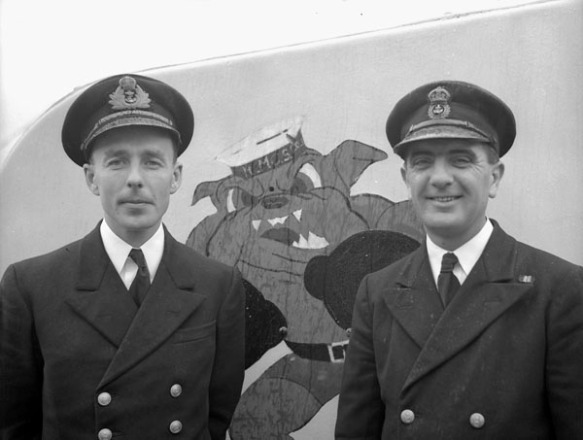By Renaud Séguin
On September 10, 1941, off the coast of Greenland, the crews of two Royal Canadian Navy (RCN) corvettes, Her Majesty’s Canadian Ships (HMCS) Chambly and Moose Jaw, were able to locate and sink U-501 as the U-boat lay in wait to ambush Allied Convoy SC-42, sailing from Sydney, Nova Scotia, with supplies for Great Britain.
The two corvettes were to take part in training exercises at sea, so that their crews, largely made up of recruits, could become familiar with anti-submarine warfare. In the face of the growing threat from German submarines, the two vessels quickly ended their training to reinforce the Allied convoy.

HMCS Arrowhead, a corvette of the same class (Flower) as HMCS Chambly and HMCS Moose Jaw (MIKAN 4821042).
An RCN expert in anti-submarine warfare, Commander James D. “Chummy” Prentice, Chambly’s captain and Senior Officer Corvettes, quickly decided that the best option would be to move ahead of the convoy to surprise any German submarines. The navigation skills of Mate A. F. Pickard made it possible for the two corvettes to reach the area identified by Prentice in less than six days.
At about 21:30, Chambly got an ASDIC (better known by its American name, “sonar”) contact. Quickly, Chambly’s crew began releasing five depth charges. Despite a few mistakes owing to inexperience, the first two charges caused enough damage to force the submarine to surface close to Moose Jaw.

Mate A. F. Pickard and Chief Engine Room Artificer W. Spence, St. John’s, Newfoundland, 1942. The two men played key roles in the corvette HMCS Chambly’s sinking of the German submarine U-501 on September 10, 1941. (MIKAN 3576697)
Surprised by the appearance of the U-boat, the crew of Moose Jaw was unable to open fire immediately with either their rapid-fire naval gun or the machine guns. Lieutenant F. E. Grubb, commanding officer of Moose Jaw, rapidly gave the order to advance on and ram the submarine. Far from being a complete improvisation, this was a manoeuver often attempted by Canadian corvettes. At close range, it was the best option for sinking German U-boats which, at night, in rough seas, presented a small moving target.
Before the initial charge, Lieutenant Grubb was astonished to see the German captain abandon the submarine to leap onto Moose Jaw’s deck! However, it was only after being rammed by the corvette, under fire of its naval gun, that the U-boat halted.

A boarding party from HMCS Chilliwack in a whaler alongside German submarine U-744, March 6, 1944 (MIKAN 3623255).
A boarding party from Chambly, led by Lieutenant E. T. Simmons, attempted to take possession of the submarine. The attempt had to be abandoned, because the U-boat was sinking rapidly. One member of Chambly’s crew, William Irvin Brown, drowned during the operation. Like the more than 200 crew members of the 15 merchant ships in the SC-42 convoy sunk by German submarines, the Toronto native, father of a one-year-old daughter, gave his life to supply Great Britain and the armed forces protecting it. Many other Canadians also lost their lives during the Battle of the Atlantic.
Related resources
- “Naval reports of proceedings: SC 42,” 8280-SC42, MIKAN 4686204
- “Sub attacks – HMCS CHAMBLY,” NSS8910-331/21, MIKAN 901932
- Service File of William Irvin Brown, A4212, RG 24 29029.
Renaud Séguin is a military archivist in the Government Archives Division at Library and Archives Canada.

Thanks Renaud for your interesting and. Informative article.I would welcome more postings from you. Kindest Regards Will (Wigan Lancashire)
great post. thx
my good buddy Rev Doug Young(Now deceased) was a ping merchant on the Chambly and as he told me some years ago ; it was very disheartening to be sent back to Canada before 6 June because the corvettes were going to be involved in mine clearing etc and the Ping merchants(Sonar operators for you landlubbers) were not needed for that part of the invasion.
Thanks for the post, my father served aboard HMCS Chambly as a sparkler / coder for the duration. Oddly enough my mother served with the Wrens as a comm rating. The two “talked” to each other during WW2 but did not meet until the 50’s in Vancouver
Pingback: Man jumps overboard, Arrested Naked. the News #16 | Halifax Shipping News.ca
Reblogged this on battleoftheatlantic19391945 and commented:
76TH BATTLE OF THE ATLANTIC/1939-1945, SUNDAY, May 02, 2021@18:51-OUR ROYAL CANADIAN NAVY;S FIRST U-BOAT SUNK, SEPT., 10/1941, SLOW CONVOY 42, H.M.C.SHIPS CHAMBLY K 116 and MOOSE JAW K 164, SINK U-501.
H.M.C.SHIPS…CHILLIWACK K 131, GATINEAU H 61, CHAUDIERE H 99, ST. CATHERINES K 325, FENNEL, H.M.SHIPS KENILWORTH CASTLE, ICARUS I 03, SINK U-744, on March 06, 1944.
BLOG CREDIT: Library and Archives Canada.
Yours Aye: Brian Murza…Killick Vison, W.W.II Naval Researcher-Published Author, Niagara Falls, Ontario, Canada.
”12/02/2022, 05:42-H.M.C.S. during W.W.II/1939-1945; HIS MAJESTY’S CANADIAN SHIPS, CHAMBLY K 116, AND MOOSE JAW K 164!!!”
Yours Aye-Brian CANUCK Murza, W.W.II Naval Researcher-Published Author, Niagara Region, Ontario, Canada.